A question can arise in one’s mind: Can women wear men’s shoes? You’re not alone. Many women are drawn to men’s sneakers, boots, or casual shoes—for their style, durability, or wider fit. Men’s shoes often offer designs or widths that women’s options don’t, making them an appealing choice for comfort-conscious shoppers.
While men’s and women’s footwear differ in sizing, shape, and proportions, wearing men’s shoes is entirely possible with the right approach to sizing, fit, and comfort.
In this comprehensive guide, we’ll cover everything from downsizing tips and width considerations to long-term comfort strategies. This will help you confidently select men’s shoes that fit and feel perfect.
Can Women Wear Men’s Shoes? Understanding The Sizing
1. Understand the Difference Between Men’s and Women’s Shoe Sizes
Men’s and women’s shoes may look similar, but they differ primarily in size scale and width, which can significantly impact fit and comfort. Understanding these differences is essential if you’re considering wearing men’s shoes.
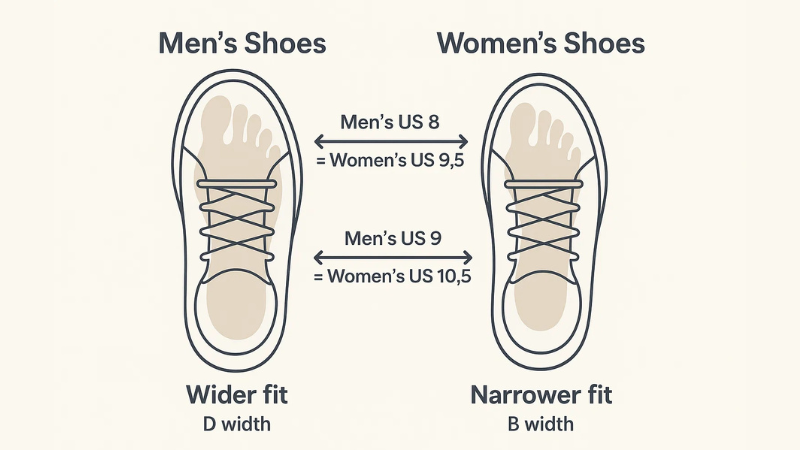
Size Scale Differences
Typically, a men’s shoe is about 1–1.5 sizes smaller than its women’s equivalent in U.S. sizing. For example:
Men’s US 8 ≈ Women’s US 9.5
Men’s US 9 ≈ Women’s US 10.5
This means that if you normally wear a women’s US 9, you would likely need a men’s US 8 to achieve a similar fit.
Width Differences
Width is another important factor. Men’s shoes generally have a wider fit (D width) compared to women’s shoes, which are usually narrower (B width). This extra room can make men’s shoes feel spacious on narrower feet, which is why many women prefer adding insoles, heel grips, or thicker socks to ensure a secure and comfortable fit.
Key Takeaway
When choosing men’s shoes, it’s not just about length—you need to consider both size and width to get the best fit. Paying attention to these differences helps prevent discomfort, slipping, or pinching, making men’s shoes a practical and stylish choice for women.
2. Know How to Convert Men’s Shoes to Women’s Sizing
If you’re wondering how to wear men’s shoes as a woman, understanding size conversion is the first step. Men’s and women’s shoes use different sizing scales, but with a few simple adjustments, you can find a perfect fit.
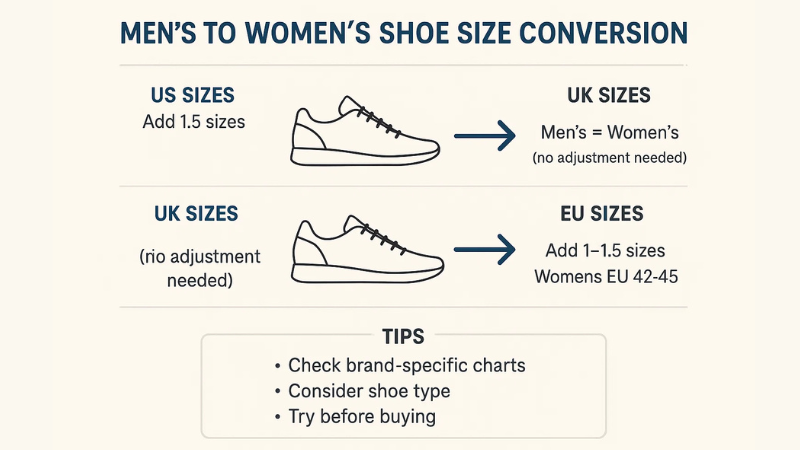
Conversion Guidelines
US Sizes: Add 1.5 sizes to the men’s US size to get the equivalent women’s size.
- Example: Men’s US 8 → Women’s US 9.5
UK Sizes: Typically, men’s and women’s UK sizes are the same, so no adjustment is needed.
EU Sizes: Add about 1–1.5 sizes to convert men’s EU sizes to women’s.
- Example: Men’s EU 41 ≈ Women’s EU 42–42.5
Pro Tips for the Best Fit
- Check Brand-Specific Charts:
Each brand may run slightly small, large, or wide compared to standard sizes. Always verify with their official sizing guide.
- Consider the Shoe Type:
Sneakers, running shoes, and boots may fit differently due to shape, sole thickness, or upper material. Adjust your conversion accordingly.
- Try Before Buying When Possible:
Shoes worn for long hours—like work sneakers or hiking boots—should be tried on to prevent discomfort. If buying online, check the return policy to allow easy exchanges.
Key Takeaway
Converting men’s shoe sizes to women’s doesn’t have to be confusing. By adding 1–1.5 sizes and paying attention to width and style, women can comfortably enjoy men’s shoes without sacrificing fit or comfort.
If you fail to choose the right size, the shoe will be uncomfortable for you. And it will cause foot pain if you wear it for a long time. Check out how to prevent foot pain from standing all day and relax after a long day at work.
3. Do Women’s Feet Fit Comfortably in Men’s Shoes?
Yes—many women find that men’s shoes can be comfortable and practical, but achieving the right fit depends on foot shape, shoe style, and personal preference.
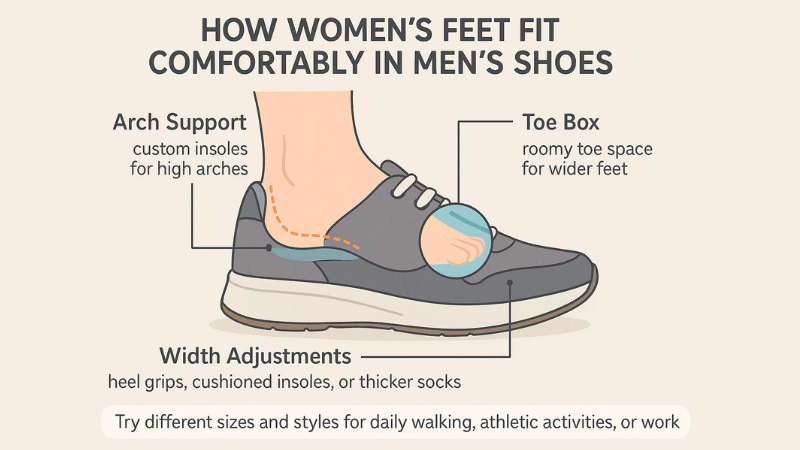
Key Fit Considerations
- Arch Support:
Men’s shoes often have slightly different arch heights compared to women’s shoes. Women with high arches or specific support needs may benefit from custom insoles to improve comfort during long wear.
- Toe Box:
Men’s shoes usually offer a roomier toe box, which can be ideal for women with wider feet or those who prefer extra space for movement.
- Width Adjustments:
Women with narrower feet might notice a looser fit in men’s shoes. Adding heel grips, cushioned insoles, or thicker socks can prevent slipping and improve stability.
Choosing the Right Fit
Some women enjoy the slightly oversized feel of men’s sneakers or casual shoes, while others prefer to size down for a snugger, more supportive fit. The best approach is to try on different sizes and styles, considering how the shoe will be used—whether for daily walking, athletic activities, or work.
By paying attention to these factors, women can comfortably wear men’s shoes without compromising support, stability, or style.
For more tips on foot comfort and support, see Why Buy Good Shoes For Nurses.
4. Are Men’s Shoes Wider Than Women’s Shoes?
Yes—men’s shoes are generally wider than women’s shoes. Most men’s footwear is designed with a D width, while women’s shoes typically use a B width. This extra width can make men’s shoes feel roomy or loose on narrower feet, but it can also be a benefit for those seeking more space or comfort.
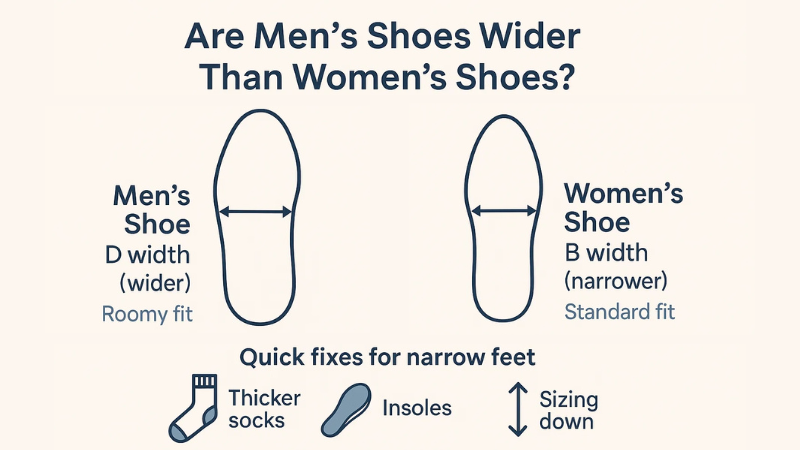
Quick Fixes for Narrow Feet in Men’s Shoes
- Use Thicker Socks:
Adding cushioned or thicker socks can fill extra space and improve overall fit.
- Add Insoles:
Arch-support or heel-stability insoles help prevent slipping and provide a snug, comfortable feel.
- Consider Sizing Down:
For formal shoes or tight-fitting styles, sizing down slightly can compensate for the extra width without compromising comfort.
Key Takeaway
Understanding the width difference is crucial when women wear men’s shoes. With simple adjustments like insoles or thicker socks, you can enjoy the style and durability of men’s footwear without compromising fit or support.
If you have flat feet, you need specialized shoes for proper support and comfort. But finding those shoes can turn out to be a real hassle. That’s why we’ve come up with the best shoes for flat feet for you to choose from, according to your budget and style.
5. Men’s to Women’s Shoe Conversion Chart (US, UK, EU)
When shopping for shoes across genders, knowing how to convert sizes is key. Men’s and women’s shoes differ in both length and width, so using a conversion chart helps ensure a comfortable, accurate fit.
Men's US | Women's US | UK | EU |
6 | 7.5 | 5 | 38 |
7 | 8.5 | 6 | 39 |
8 | 9.5 | 7 | 41 |
9 | 10.5 | 8 | 42 |
10 | 11.5 | 9 | 43 |
11 | 12.5 | 10 | 44 |
How to Use This Chart
- Start with Your Men’s Size:
Identify your usual men’s size in the US system.
- Add 1.5 Sizes for Women’s US:
As shown in the chart, women’s sizes are typically 1.5 sizes larger than men’s in US measurements.
- Check UK and EU Equivalents:
If shopping internationally, use the UK or EU columns to match sizes accurately.
Pro Tips for a Perfect Fit
- Always check brand-specific sizing charts, as some brands may run smaller or wider than standard.
- Consider shoe type and width: Sneakers, boots, and formal shoes may fit differently even in the same size.
- If buying online, compare your foot length in inches or centimeters with the brand’s chart to avoid surprises.
Getting all these qualities in one pair of shoes is really hard. If you visit the market, you’ll find many options available. But finding the perfect one is difficult.
Don’t worry, we’ve solved the problem for you. Check out the best shoes for nurses of this year for the perfect shoes you need. You can choose one according to your budget and style preference from there.
Benefits of Women Wearing Men’s Shoes
Many women choose men’s sneakers not just for style, but also for fit, comfort, and practicality. Here are some of the key benefits:
1. Cost Savings
Men’s sneakers are often less expensive than their women’s counterparts or may appear in more frequent discounts. This makes them a smart choice for women looking for high-quality shoes at a better price.
2. Wider Fit
Men’s shoes generally have a roomier width, which is perfect for women with wider feet, bunions, or foot swelling. A wider fit can reduce pressure points, prevent discomfort, and provide better overall foot support.
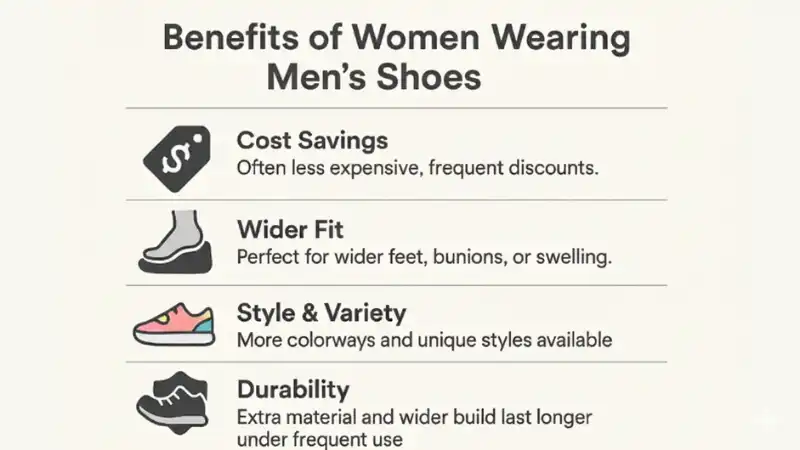
3. Style & Variety
Men’s collections often include neutral, bold, or unique colorways that aren’t always available in women’s lines. This gives women more options to match personal style preferences or create versatile, casual, or sporty looks.
4. Durability
Certain men’s models—like running shoes, boots, or high-performance sneakers—can be slightly sturdier than women’s versions. The extra material and wider build often translate into shoes that last longer under frequent use.
Key Takeaway
Wearing men’s sneakers can be a practical and stylish choice for women, offering better fit, durability, and affordability while expanding your footwear options.
For more on choosing comfortable and durable sneakers, see Best Sneakers for Nurses.
FAQs
Can women wear men’s shoes every day?
Yes, as long as the size and width are comfortable. Consider insoles or socks for extended wear.
Will men’s shoes feel too loose for women?
Possibly, depending on foot width. You can use insoles or choose a slightly smaller men’s size.
Are men’s shoes better for wide feet?
Absolutely. The D width in men’s shoes accommodates wider feet better than standard women’s B width shoes.
Can women wear men’s athletic shoes for running?
Yes, many women prefer men’s running shoes for wider toe boxes and sturdier designs.
Do sizes differ across brands?
Yes, always check the specific brand’s sizing chart before purchasing.
Conclusion
Yes, women can comfortably wear men’s shoes when they pay attention to sizing, fit, and foot support. Men’s shoes often provide wider fits, durable construction, and a variety of styles that may not be available in women’s collections.
To ensure comfort and prevent foot fatigue:
- Consider arch support and use insoles if needed.
- Make width adjustments with thicker socks or heel grips.
- Always refer to sizing charts and, if possible, try shoes on before purchasing.
By following these simple tips, you can enjoy the style, comfort, and versatility of men’s footwear without compromising fit.

Leave a Reply